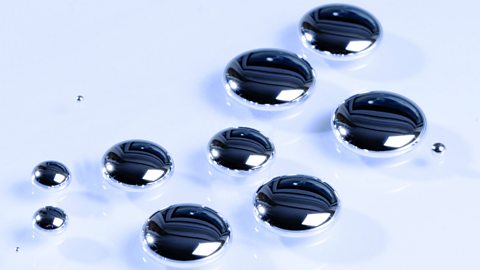What are acids?
Acids and alkalis are common in daily life. They are found in the home, in our bodies, in industry, car batteries and school science labs. One of the jobs of a chemist is to tell the difference between an acid and an alkali and know how they react with each other and with chemicals.
Acids
Acids have a sour taste ÔÇô but it is much too dangerous to taste a liquid to find out if it is an acid! So, other ways of detecting acids need to be used.
Dilute acids
Strong acids such as hydrochloric acid, sulfuric acid and nitric acid are laboratory acids that have been mixed with a lot of water before putting them out for use. This is called diluting the acid. Their bottles are labelled with a warning symbol to show that they can irritate your skin or cause some other minor harm to health.
This means that if any of them come into contact with your skin, it may become red or blistered. You must wash off any spills with plenty of water, otherwise your skin may soon feel as if it is burning. It is important to remember than when diluting acid you add acid to water not water to acid.
Water in acid, you're blasted.Acid in water, you got 'er.
Concentrated acids
Concentrated acids are acids mixed with very little water. They are much more dangerous than dilute acids. Concentrated acids are corrosive. They can attack metals and destroy skin if spilled. Their bottles are labelled with a warning symbol to show that they are corrosive.
Weak acids
Laboratory acids are far too dangerous to taste! However, you will have swallowed some dilute, weak acids. Acids have a sour taste, like vinegar, which contains ethanoic acid, and lemons, which contain citric acid. These are safe to use in food, but they can still sting if they get into a cut or into your eyes. For instance, an ant sting contains formic acid. There is formic acid in a bee sting too.
The table shows common weak acids found in food:
Summary
- A dilute acid has a sour or sharp taste
- Acids can be harmful and corrosive
- Common examples: vinegar, lemon juice, car batteries
Bases and alkalis
A base is a substance that can react with an acid and neutralise it. That means the base and the acid cancel each other out. A base is chemically opposite to an acid.Bases are usually:
- metal oxides, such as copper oxide
- metal hydroxides, such as sodium hydroxide, or
- metal carbonates, such as calcium carbonate
An alkali is a base that dissolves in water.
The table shows two examples of bases:
| Copper oxide | Sodium hydroxide | |
|---|---|---|
| Can it neutralise acids? | Yes | Yes |
| Is it a base? | Yes | Yes |
| Can it dissolve in water? | No | Yes |
| Is it an alkali? | No | Yes |
Sodium hydroxide is an alkali because it is a base, and it dissolves in water.
Common school lab alkalis include
- sodium hydroxide
- potassium hydroxide
- ammonia
Bases in the laboratory
Like acids, alkali bottles are labelled with symbols to warn that they may make your skin red or blistered unless you wash off any spills with plenty of water. They must be used with caution.
Alkalis feel soapy when they get on your skin, so it is easy to tell when you have had an accident and must wash your hands.
Just like concentrated acids, concentrated alkalis are corrosive. They can attack metals and destroy skin if spilled.
Concentrated alkalis are just as dangerous as concentrated acids, sometimes more dangerous, but many people do not realise this.

Health hazards
May be harmful or an irritant e.g. weak or dilute acid or alkali
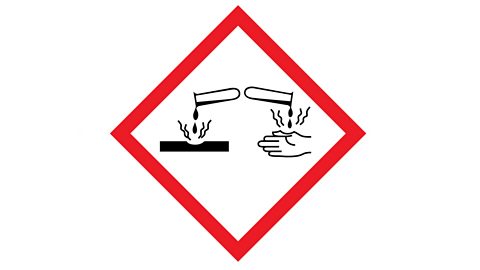
Corrosive
Burns and destroys living tissue e.g. strong or concentrated acid or alkali
Alkalis in the home
Alkalis react with oils and fats, so they are often used in household cleaners. For example, drain cleaners and oven cleaners usually contain sodium hydroxide. Ammonia is also commonly used in cleaners, and it can be recognised by its choking smell.
It is wise to wear gloves when using these substances, otherwise they will react with your skin and burn it.
Weak bases and alkalis are found in toothpaste, indigestion tablets (to help cure an upset stomach) and baking powder.
Summary
- A base is a substance that can react with acids and neutralise them
- If a base dissolves in water, we call it an alkali
- Dilute alkalis have a soapy feel to them
- Alkalis can be harmful and corrosive
- Common examples: toothpaste, oven cleaner, indigestion tablets, baking powder
Care!
You should always take care in the laboratory, but strong acids and alkalis are particularly dangerous. Spilt dilute acids or alkalis should be immediately wiped up using a wet paper towel. The acid or alkali becomes more diluted, and so becomes less dangerous.
Safe working
- Wear protective gear (goggles, long-sleeved clothes, and gloves) when using acids and alkalis
- Do not allow acids or alkalis to come in contact with skin or eyes
- Limit the volume of acids and alkalis used in the lab
- Cap the bottles of acid and alkalis tightly
Indicators and the pH scale
All solutions in water are either acidic, alkaline or neutral:
- we get an acidic solution when an acid is dissolved in water
- we get an alkaline solution when a base is dissolved in water
- solutions that are neither acidic nor alkaline are neutralPure water is neutral, and so is petrol.
We tell them apart using indicators which change colour when added to acidic or alkaline solutions.You can prepare homemade indicators from red cabbage or beetroot juice - these will help you see if a solution is acidic or alkaline.Litmus and universal indicator are two indicators that are commonly used in the laboratory.
Litmus
Litmus indicator solution turns red in acidic solutions and blue in alkaline solutions. It turns purple in neutral solutions.
Litmus paper is usually more reliable than other indicators and comes as red litmus paper and blue litmus paper. The table shows the colour changes it can make.
| Red litmus paper | Blue litmus paper | |
|---|---|---|
| Acidic solution | Stays red | Turns red |
| Neutral solution | Stays red | Stays blue |
| Alkaline solution | Turns blue | Stays blue |
- Acid turns blue litmus paper red
- Alkali turns red litmus blue
Litmus is blue in alkali
One way to remember this is: Blue Base(An alkali is a base dissolved in water)
Notice how we say 'stays red'. This is better than saying 'nothing' or 'stayed the same', because it tells us the colour we actually see.
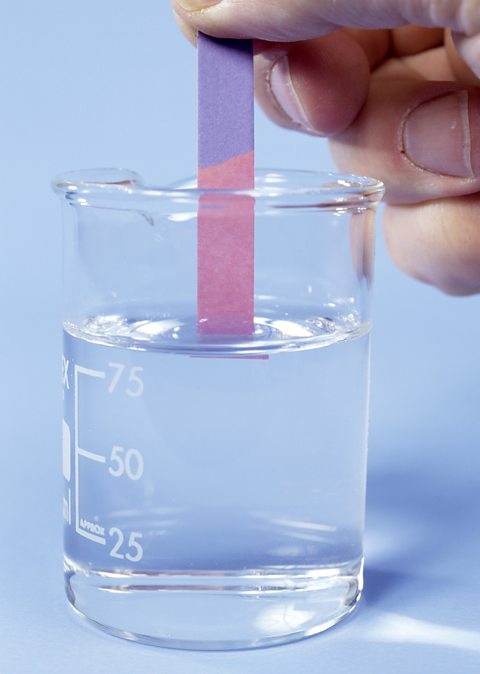
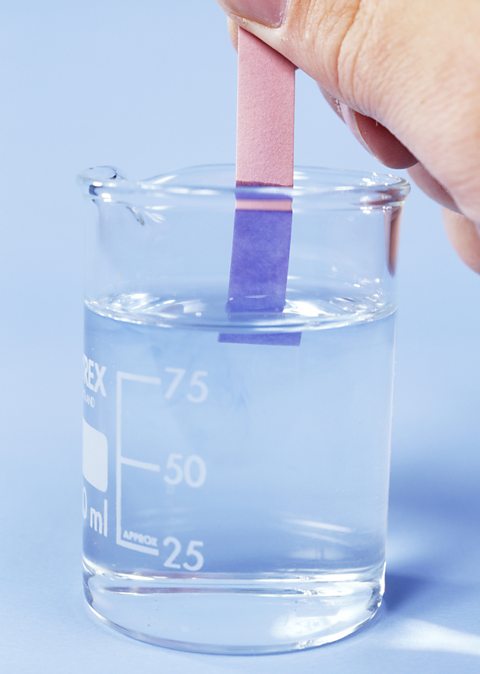
Universal indicator and the pH scale
Universal indicator is supplied as a solution or as universal indicator paper. It is a mixture of several different indicators. Unlike litmus, universal indicator can show us how strongly acidic or alkaline a solution is, not just that the solution is acidic or alkaline. This is measured using the pH scale, which runs from pH 0 to pH 14.
- Neutral solutions have a pH of 7
- Acids have a pH less than 7
- Alkalis have a pH greater than 7
Universal indicator has many different colour changes, from red for strongly acidic solutions to dark purple for strongly alkaline solutions. In the middle, neutral pH 7 is indicated by green.
When you use universal indicator paper, you get more accurate results if you only put a small spot of the test solution on the paper, and then leave the colour to develop for about 30 seconds before comparing it with the colour chart.These are the important points about the pH scale:
- neutral solutions are pH 7 exactly
- acidic solutions have pH values less than 7
- alkaline solutions have pH values more than 7
- the closer to pH 0 you go, the more strongly acidic a solution is
- the closer to pH 14 you go, the more strongly alkaline a solution is
Neutralisation
If an alkali is added to an acid, or an acid is added to an alkali they cancel each other out. If exactly the right amount is added, a neutral solution is formed. The reaction is called neutralisation. Heat energy is released in this reaction, so the reaction mixture warms up.
Everyday examples of neutralisation
Acids and alkalis are all around us and commonly one needs to be balanced out by the other:
- Farmers and gardeners use lime (calcium oxide) to neutralise acid soils.
- Your stomach contains hydrochloric acid, and too much of this causes indigestion. Indigestion (or antacid) tablets contain alkalis such as magnesium hydroxide and magnesium carbonate to neutralise the extra acid.
- Bee stings are acidic. They can be neutralised using baking powder, which contains sodium hydrogen carbonate.
- Wasp stings are alkaline. They can be neutralised using vinegar which contains ethanoic acid
Bees with Baking powder Wasps with Wine vinegar

pH of the mouth
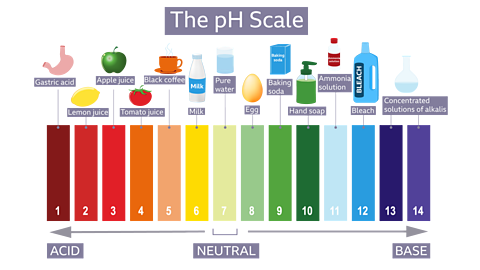
Healthy saliva is usually slightly acidic ÔÇô in the range pH 5.6 to 6.9.
If saliva is too acidic the risk of tooth decay and cavities increases.
If saliva is too alkaline it can cause enamel erosion of the teeth.

Sugary foods tend to have a high acid content. Other foods such as fruits, tomatoes, coffee, and fizzy drinks are also acidic. These can make saliva too acidic.
The best way to reduce the effects of these acidic foods and drinks is to drink water during and after eating, which dilutes the acid.
Cleaning your teeth after eating is good too, as toothpaste is alkaline and this will help neutralise the acid.
Alkaline foods can help, such as rice and sweet corn. A slice of cheese at the end of a meal can help rebalance pH levels too.
A closer look at neutralisation reactions
A neutralisation reaction occurs when an acid is added to an alkali. An indicator is used to tell us when the neutralisation point has been reached.
When an acid reacts with an alkali in this way a salt and water are formed.
Acid + alkali  salt + water
We say that the acid and alkali are the reactants, and the salt and water are the products of a neutralisation reaction. In chemistry a salt is any compound formed by the neutralisation of an acid by a base or an alkali. It does not just refer to table salt.
Metal oxides
Metal oxides are bases. Here is the general word equation for what happens in their neutralisation reactions with acids:
metal oxide + acid  a salt + water
The salt made depends on the metal oxide and the acid used. For example, copper chloride is made if copper oxide and hydrochloric acid are used:
copper oxide + hydrochloric acid  copper chloride + water
Metal hydroxides
Metal hydroxides are bases. Some of them dissolve in water, so they form alkaline solutions. Here is the general word equation for what happens in their neutralisation reactions with acids:
metal hydroxide + acid  a salt + water
As with metal oxides, the salt made depends on the metal hydroxide and the acid used. For example, sodium sulfate is made if sodium hydroxide and sulfuric acid are used:
sodium hydroxide + sulfuric acid  sodium sulfate + water
Notice that a salt plus water is always produced when metal oxides or metal hydroxides react with acids.
Metal carbonates
Most carbonates are insoluble (they do not dissolve) in water. They also neutralise acids, making a salt and water, but this time we get carbon dioxide gas too.Here is the general word equation for what happens:
metal carbonate + acid  a salt + water + carbon dioxide
The reaction fizzes as bubbles of carbon dioxide are given off. This is easy to remember because we see the word 'carbonate' in the chemical names. Carbonated water is fizzy water.For example, copper carbonate reacts with nitric acid to form copper nitrate, water and carbon dioxide:
copper carbonate + nitric acid  copper nitrate + water + carbon dioxide
Naming salts
You may have spotted a trend in how a salt is named.The name has two parts. The first part comes from the metal, metal oxide or metal carbonate. The second part comes from the acid:
- nitric acid always produces salts that end in nitrate
- hydrochloric acid always produces salts that end in chloride
- sulfuric acid always produces salts that end in sulfate
You can always work out the name of the salt by looking at the reactants:
For example, if potassium hydroxide reacts with nitric acid, the products will be the salt, potassium nitrate, and water.
Example 1: sodium chloride
Sodium chloride is the chemical name for common table salt. How can we make sodium chloride? The first part of the name is 'sodium', so we need a base containing sodium. We could use sodium hydroxide, which is soluble and so forms an alkaline solution. The second part of the name is 'chloride', so we need to use hydrochloric acid.Here are the equations for the reaction:
sodium hydroxide + hydrochloric acid  sodium chloride + water
Just enough hydrochloric acid is added from a burette to neutralise the sodium hydroxide.
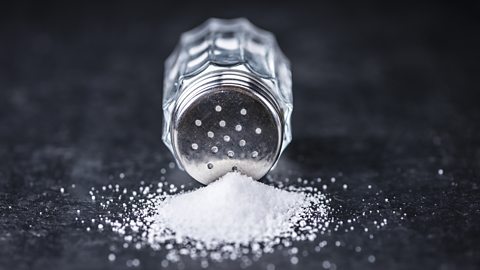
You can check the reaction mixture using universal indicator or a pH meter to see when it becomes pH 7. Sometimes a little acid or alkali is left over, so it would not be safe to taste the sodium chloride solution produced.The salt formed is dissolved in the water and cannot be seen. Salt crystals will remain when the water has evaporated. The solution can be poured into an evaporating dish and heated using a Bunsen burner to evaporate the water.

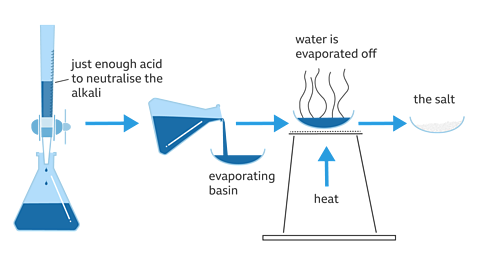
Example 2: copper sulfate
How can we make copper sulfate? The first part of the name is 'copper', so we need a base containing copper. We could use copper oxide or copper carbonate, for example. The second part of the name is 'sulfate', so we need to use sulfuric acid.Here are the equations for those reactions:
copper oxide + sulfuric acid  copper sulfate + water
Or
copper carbonate + sulfuric acid  copper sulfate + water + carbon dioxide
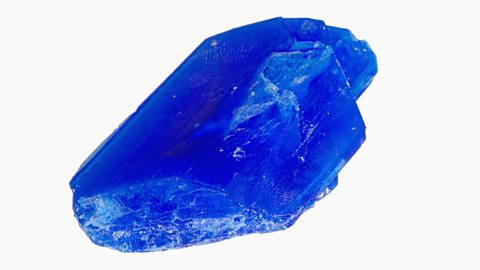
Copper oxide and copper carbonate are insoluble in water, so usually you add an excess (more than enough to react with all the acid) then filter the mixture. The excess solid stays in the filter paper as a residue. The copper sulfate solution drips through as a filtrate. This can be warmed to evaporate the water, leaving the salt, copper sulfate crystals, behind.

The table shows some more examples:
| Metal | Acid | Salt | ||
|---|---|---|---|---|
| Copper oxide | reacts with | Hydrochloric acid | to make | Copper chloride |
| Sodium hydroxide | reacts with | Sulfuric acid | to make | Sodium sulfate |
| Zinc oxide | reacts with | Sulfuric acid | to make | Zinc sulfate |
Note that ammonia forms ammonium salts when it reacts with acids. For instance, ammonia reacts with hydrochloric acid to make ammonium chloride. It is also worth noting that ammonia and acid reactions do not produce water.
Salts and their uses
Salts have a variety of properties and uses. Sodium chloride, or table salt, used to season food and to increase the boiling point of water, is just one.
Here are some more:
| Name of salt | Use | Reactants |
|---|---|---|
| Potassium chloride | Healthier substitute for common table salt | Potassium hydroxide with hydrochloric acid |
| Potassium nitrate | Used in fertiliser and gunpowder | Potassium hydroxide and nitric acid |
| Copper sulphate | Used as a weed killer and insecticides | Copper oxide and sulphuric acid |
| Calcium phosphate | Used in fertilisers and baking power | Calcium carbonate and phosphoric acid |
| Calcium sulphate | Plaster casts for broken legs and arms | Calcium carbonate and sulphuric acid |
| Magnesium sulphate | As Epsom salts or bath salts to soak in and treat minor aches and pains. Has also been used to treat constipation and insomnia | Magnesium carbonate and sulphuric acid |
Classifying materials
This is an example of a common experiment used to classify material which should help you to understand how to work scientifically.
Aim of the experiment
To classify some mystery substances as acids or bases.
Method
- If the substance is a liquid, add three drops of universal indicator and compare the colour to a colour chart.
- If the substance is a solid, try to dissolve it in some water and then test its pH.
- Test to see what effect the substance has on the pH of an acid or alkaline solution to see if it neutralises it.
Risks
Acids and alkalis are irritants. If they get onto your skin, rinse them off with soap and water.
Typical results
| Substance | Liquid | pH of liquid | Solid | Dissolve | pH of solution | Acid effect | Alkaline effect |
|---|---|---|---|---|---|---|---|
| A | Yes | 7 | No change | No change | |||
| B | No | Yes | Yes | 3 | No change | Neutralises alkali | |
| C | No | Yes | No | Neutralises alkali | No change | ||
| D | Yes | 2 | No change | Neutralises alkali | |||
| E | No | Yes | Yes | 12 | Neutralises alkali | No change | |
| F | Yes | 13 | Neutralises alkali | No change |
What the results mean
Substance:A is neutral and has no effect on acids or alkalis.B is a soluble acid.C is an insoluble base because it neutralises an acid.D is an acid solution.E is a soluble base, so it dissolves to make an alkali.F is also an alkali.
Evaluation
- Your measurements are accurate if they are close to their true value.
- Your measurements are precise if they are similar when completed again.
- Your experiment is repeatable if you get precise measurements when it is repeated.
- Your experiment is reproducible if others get precise measurements when they repeat it.
More on Chemistry
Find out more by working through a topic
- count1 of 8

- count2 of 8

- count3 of 8
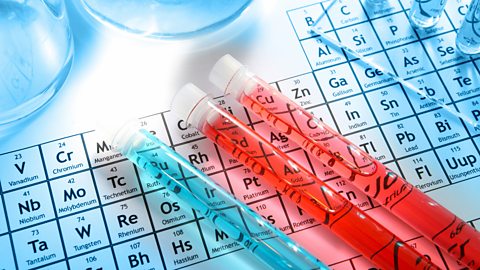
- count4 of 8
